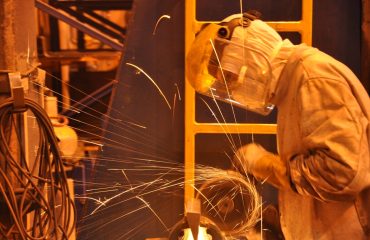Steel, a ubiquitous material in construction and infrastructure, faces a formidable challenge in saltwater environments: corrosion. The relentless assault of salt water significantly reduces the lifespan of steel structures, leading to costly repairs and safety hazards. Understanding the mechanisms of corrosion and employing effective mitigation strategies is crucial for ensuring the long-term durability of steel in these demanding conditions.
The Mechanisms of Saltwater Corrosion on Steel
Saltwater corrosion is a complex electrochemical process. When steel is exposed to saltwater, an electrochemical cell is formed. The steel acts as an anode, losing electrons and dissolving into iron ions (Fe2+). These ions react with oxygen and water to form iron oxides, commonly known as rust. The cathode, often another less reactive metal or an area of the steel with a different potential, gains electrons and reduces oxygen. This process is accelerated in saltwater due to the high concentration of chloride ions (Cl–). These ions penetrate the protective passive layer of iron oxide, disrupting its formation and accelerating the corrosion process. This is particularly true in areas with high salinity and oxygen levels.
The Role of Chloride Ions in Accelerated Corrosion
Chloride ions are the primary culprits behind the aggressive corrosion of steel in saltwater. They are highly mobile and effectively disrupt the passive oxide layer on the steel surface. This passive layer, a thin film of iron oxide, normally protects the steel from further corrosion. However, chloride ions penetrate this layer, leading to its breakdown and the formation of pits. These pits act as localized anodes, concentrating the corrosion process and accelerating the degradation of the steel. The depth and extent of these pits can significantly compromise the structural integrity of the steel component over time.
Selecting Corrosion-Resistant Steel Alloys
Not all steels are created equal when it comes to saltwater resistance. Certain alloying elements significantly enhance the corrosion resistance of steel. Stainless steels, for example, contain chromium (Cr) which forms a passive chromium oxide layer that is much more resistant to chloride ion penetration than the iron oxide layer. The higher the chromium content, the greater the corrosion resistance. Other alloying elements like molybdenum (Mo) and nickel (Ni) further improve corrosion resistance in aggressive environments. The selection of the appropriate steel alloy depends on the specific application, the severity of the saltwater exposure, and the desired lifespan of the structure.
Protective Coatings: A Crucial Defense Against Saltwater
Applying protective coatings is a vital strategy for extending the lifespan of steel in saltwater environments. Various coatings are available, each with its own advantages and disadvantages. Zinc coatings (galvanization) provide cathodic protection, meaning the zinc acts as a sacrificial anode, corroding instead of the steel. Paint systems, particularly those with high-performance polymers, provide a barrier between the steel and the saltwater. Other options include epoxy coatings, polyurethane coatings, and specialized marine coatings formulated to withstand harsh conditions. The choice of coating depends on factors such as cost, durability requirements, and the specific environmental conditions.
Maintenance and Inspection: Prolonging the Life of Steel Structures
Regular maintenance and inspection are critical for ensuring the long-term durability of steel structures in saltwater environments. Regular cleaning can remove accumulated salt deposits and debris that can accelerate corrosion. Visual inspections can identify early signs of corrosion, allowing for timely repairs and preventing further damage. More advanced techniques, such as ultrasonic testing and magnetic particle inspection, can detect internal corrosion and defects that are not visible to the naked eye. A proactive maintenance program, combined with regular inspections, is crucial for minimizing corrosion and extending the lifespan of steel structures in saltwater.
In conclusion, understanding the mechanisms of saltwater corrosion and employing appropriate mitigation strategies is essential for ensuring the long-term performance and safety of steel structures in marine environments. By carefully selecting corrosion-resistant alloys, applying effective protective coatings, and implementing a robust maintenance program, we can conquer corrosion and extend the life of steel in even the most challenging saltwater conditions.
SEO Tags: saltwater corrosion, steel corrosion, marine corrosion, corrosion protection, stainless steel




